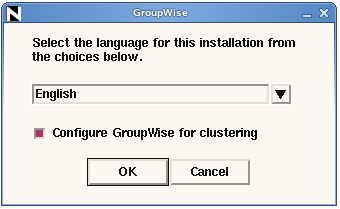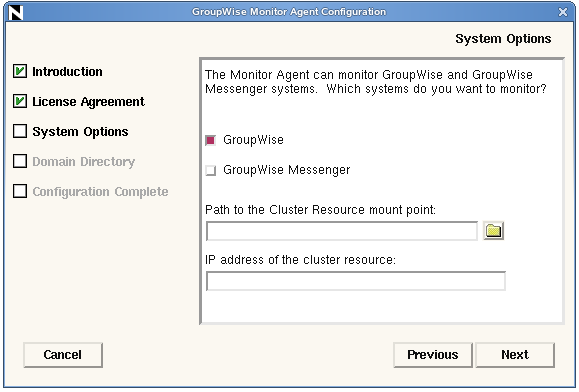6.3 Setting Up GroupWise Monitor in a Linux Cluster
GroupWise Monitor depends on the Apache Web server on Linux. However, Apache is not typically installed in a cluster and the Monitor Application is not supported in a cluster. Therefore, these instructions do not include that task.
6.3.1 Installing and Configuring the Linux Monitor Agent on Each Node in Your Cluster
The Monitor Agent must be installed on each node in the Monitor Agent failover list (Monitor Agent Clustering Worksheet item 4). The Monitor Application is installed to your Web server and is therefore not installed on nodes in the cluster.
Running the Linux Monitor Installation Program on the Preferred Node
-
Make sure that the Monitor Agent software is available in the software distribution directory you created in Step 6 in Section 3.1, Setting Up a New GroupWise System in a Linux Cluster.
-
Mount the GroupWise partition (Monitor Agent Clustering Worksheet item 2) where the Monitor Agent Installation program can access a domain database.
-
From the software distribution directory, start the Installation program and select .

-
Install and configure the Monitor Agent software, following the steps provided in
Installing and Configuring the Linux Monitor Agent
inInstalling GroupWise Monitor
in the GroupWise 2012 Installation Guide.Pay special attention to the cluster resource information on the System Options page.

As a result of selecting on the preferred node, the following cluster-specific configuration actions are performed:
-
The Monitor Agent configuration file (monitor.xml) is created in mount_point/groupwise/agents/share on the shared resource so that the Monitor Agent uses the same configuration file regardless of which cluster node it is running on. The HOME_PATH option includes the mount point and the path to the database so that the configuration file is valid when mounted to each cluster node.
-
The --log startup switch in the grpwise-ma script is set to a location on the shared resource (mount_point/groupwise/agents/log) so that Monitor Agent logging information is written to the same log file regardless of which cluster node it is running on. Gateway accounting files that you can use to generate reports are stored in the acct subdirectory of this location.
-
The Monitor Agent is not configured to start automatically on system startup. In a cluster, you do not want the Monitor Agent to start automatically whenever a node restarts.
-
-
Continue with Running the Linux Monitor Agent Installation Program on Subsequent Nodes
Running the Linux Monitor Agent Installation Program on Subsequent Nodes
-
On the next node in the Monitor Agent failover list, mount the GroupWise partition (Monitor Agent Clustering Worksheet item 2) where the Monitor Agent Installation program can access a domain database.
-
From the software distribution directory you created in Step 6 in Section 3.1, Setting Up a New GroupWise System in a Linux Cluster, start the GroupWise Installation program and select .

-
Install the Monitor Agent software on the cluster node as usual, but do not use the option.
For the Monitor Agent, you do not need to import clustering data on subsequent nodes as you do for the other GroupWise agents.
-
Repeat Step 1 through Step 3 for each cluster node in the Monitor Agent failover list.
After you install the Monitor Agent on each node in its failover list, the cluster node is ready for the Monitor Agent to fail over to it.
-
Continue with Configuring the Linux Monitor Agent Web Console for SSL.
Configuring the Linux Monitor Agent Web Console for SSL
If you plan to secure the Monitor Web console using SSL, you need to provide an SSL certificate file. You can place the file on the Monitor Agent partition, rather than each node.
-
Create a directory on the Monitor Agent partition where you want to store the certificate file.
-
In the grpwise-ma script, use the --httpcertfile switch to specify the full path to the directory you created in Step 1.
Continue with Testing the Linux Monitor Agent Installation on Each Node.
Testing the Linux Monitor Agent Installation on Each Node
-
Test the Monitor by starting it as a daemon, as described in
Starting the Linux Monitor Agent as a Daemon
inInstalling GroupWise Monitor
in the GroupWise 2012 Installation Guide.rcgrpwise-ma start rcgrpwise-ma status
-
Then stop the Monitor Agent.
rcgrpwise-ma stop rcgrpwise-ma status
-
Return to Running the Linux Monitor Installation Program on the Preferred Node for each node in the Monitor Agent failover list (Monitor Agent Clustering Worksheet item 4)
When you have installed the Monitor Agent on all of the nodes in the Monitor Agent failover list, continue with Configuring the Monitor Agent Cluster Resource to Load and Unload the Linux Monitor Agent.
6.3.2 Configuring the Monitor Agent Cluster Resource to Load and Unload the Linux Monitor Agent
The properties of the Monitor Agent Cluster Resource object define how the Monitor Agent functions within the cluster, how the Monitor Agent is loaded and unloaded, and how failover and failback situations are handled. Complete the following tasks for the Monitor Agent cluster resource:
Modifying the Cluster Resource Load Script for the Linux Monitor Agent
The cluster resource load script executes whenever the Monitor Agent cluster resource comes online.
To set up the load script in iManager:
-
Expand Clusters, then click .
-
In the field, browse to the Cluster object where the Monitor Agent cluster resource is located.
-
Click the Cluster object to display the cluster resources that belong to the cluster.
-
Select the Monitor Agent cluster resource that you created when you set up the Monitor Agent partition, then click .
-
Click .
-
(Conditional) If this is an NSS volume or a shared pool, use a load script similar to the following example, depending on the configuration of your cluster and nodes:
#!/bin/bash . /opt/novell/ncs/lib/ncsfuncs # mount filesystem exit_on_error ncpcon mount /opt="noatime,nodiratime" volume_name=volume_ID # add IP address exit_on_error add_secondary_ipaddress monitor_partition_ip_address # start service exit_on_error /etc/init.d/grpwise-ma start # return status exit 0
-
In the mount filesystem section, specify the volume name and volume ID of the GroupWise partition that you are clustering (System Clustering Worksheet item 5).
-
In the add IP address section, specify the secondary IP address of the GroupWise partition (System Clustering Worksheet item 7).
-
-
(Conditional) If this is a traditional Linux volume, use a load script similar to the following example, depending on the configuration of your cluster and nodes:
#! /bin/bash . /opt/novell/ncs/lib/ncsfunc # define IP address RESOURCE_IP=gw_partition_ip_address # define filesystem type MOUNT_FS=filesystem # define device (if using EVMS) exit_on_error evms -f /var/opt/novell/ncs/ContainerActivate -rl Share ‘uname -n‘ MOUNT_DEV=/dev/evms/Share/dat # define mount point MOUNT_POINT=/mnt/mount_point_directory # mount filesystem exit_on_error mount -t $MOUNT_FS $MOUNT_DEV $MOUNT_POINT -o noatime,nodiratime # add IP address exit_on_error add_secondary_ipaddress $RESOURCE_IP # start service exit_on_error /etc/init.d/grpwise-ma start exit 0
-
In the define IP address section, specify the secondary IP address of the GroupWise partition (Monitor Agent Clustering Worksheet item 1).
-
In the define filesystem type section, specify the file system type that is in use on the nodes in the cluster (System Clustering Worksheet item 5).
-
In the define mount point section, specify the mount point directory in use for the nodes in the cluster (System Clustering Worksheet item 5).
-
-
Click to save the load script.
Modifying the Cluster Resource Unload Script for the Linux Monitor Agent
The cluster resource unload script executes whenever the Monitor Agent cluster resource goes offline.
-
On the iManager Cluster Resource Properties page of the Monitor Agent cluster resource, click .
-
(Conditional) If this is an NSS volume or a shared pool, use an unload script similar to the following example, depending on the configuration of your cluster and nodes:
#!/bin/bash . /opt/novell/ncs/lib/ncsfuncs # request service stop ignore_error /etc/init.d/grpwise-ma stop # stop service otherwise sleep 8 ignore_error pkill -fx "'/opt/novell/groupwise/agents/bin/gwmon --home /domain_directory'" # delete IP address ignore_error del_secondary_ipaddress gw_partition_ip_address # unmount filesystem exit_on_error umount /mnt/mount_point_directory # return status exit 0
-
In the stop service otherwise section, adjust the sleep command as needed so that the Monitor Agent can shut down normally on your system without being inadvertently killed by the pkill command that follows.
-
In the delete IP address section, specify the secondary IP address of the GroupWise partition.
-
In the unmount file system section, specify the mount point directory in use for the nodes in the cluster.
-
-
(Conditional) If this is a traditional Linux volume, use an unload script similar to the following example, depending on the configuration of your cluster and nodes:
#!/bin/bash . /opt/novell/ncs/lib/ncsfuncs # request service stop /etc/init.d/grpwise-ma stop # stop service otherwise sleep 8 ignore_error pkill -fx "'/opt/novell/groupwise/agents/bin/gwmon --home /domain_directory'" # define IP address RESOURCE_IP=172.16.5.18 # define mount point MOUNT_POINT=/mnt/mount_point # del the IP address ignore_error del_secondary_ipaddress $RESOURCE_IP # umount the file system exit_on_error umount $MOUNT_POINT # return status exit 0-
In the stop service otherwise section, adjust the sleep command as needed so that the Monitor Agent can shut down normally on your system without being inadvertently killed by the pkill command the follows.
-
In the define IP address section, specify the secondary IP address of the GroupWise partition.
-
In the define mount point section, specify the mount point directory used in use for the nodes in the cluster.
-
-
Click to save the unload script.
Setting the Failover List and Policies for the Linux Monitor Agent
-
On the iManager Cluster Resource Properties page of the Monitor Agent cluster resource, click .
The default policy settings are often appropriate. By default, a cluster resource:
-
Fails over automatically if the node it is running on fails
-
Starts automatically on the next node in its failover list
-
Continues running at its failover location, even after its most preferred node is again available
If you are considering changing these defaults, see the Novell Cluster Services Administration Guide for Linux for your version of OES Linux.
-
-
Under , arrange the nodes in the cluster into the desired failover list for the Monitor Agent (Monitor Agent Clustering Worksheet item 4).
-
Click .